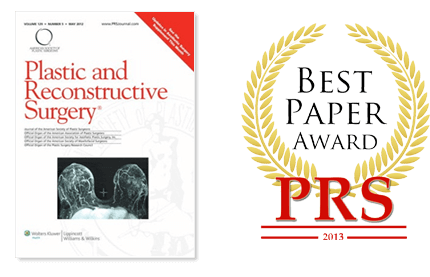
Publisher: PRS Journal
The 2012 May issue of Plastic and Reconstructive Surgery, the official medical journal of the prestigious American Society of Plastic Surgeons (ASPS), published our most recent study which further proves that pre-expanding the breast with BRAVA, prior to surgery, provides greater augmentation than fat transfer alone. Our very own Dr. Roger K. Khouri was the lead author of the study.
Background: Breast augmentation by autologous fat transfer is an appealing alternative in need of scientific validation.
Methods: In a prospective multicenter study, 81 women (age range, 17 to 63 years) wore the Brava device, a bra-like vacuum-based external tissue expander, for 4 weeks and then underwent autologous fat injection using 10 to 14 needle puncture sites into each breast in a three-dimensional fanning pattern (average, 277 ml volume injected per breast).
Patients resumed Brava wear within 24 hours for 7 or more days. Pretreatment and post treatment breast volumes were derived from three-dimensional volumetric reconstruction of magnetic resonance imaging scans, and outcomes were compared with a meta-analysis of six recent published reports on autologous fat transfer breast augmentation without expansion. Follow-up ranged from 12 months to 6 years (average, 3.7 years).
Results: Breast volume was unchanged between 3 and 6 months. Seventy-one of the treated women were compliant with Brava wear and had a mean augmentation volume at 12 months of 233 ml per breast compared with 134 ml per breast in published series without Brava (p < 0.00001). Graft survival was 82 ± 18 percent compared with 55 ± 18 percent without Brava (p < 0.00001).
There was a strong linear correlation (R 2 = 0.87) between pregrafting Brava expansion and the resultant breast augmentation. There were no suspicious breast masses or nodules. Magnetic resonance imaging recognized a 16 percent incidence of fat necrosis easily identified at 1-year mammographic evaluation.
Conclusion: The addition of Brava expansion before autologous fat grafting leads to significantly larger breast augmentations, with more fat graft placement, higher graft survival rates, and minimal graft necrosis or complications, demonstrating high safety and efficacy for the procedure.

Magnetic resonance imaging scans of breasts with contrast in a patient before left and after 3 weeks of 10 hours/day of Brava use. Note the enlarged parenchyma and the marked increased vascularity in the image right (after Brava use)

Dose-response curve generated from the measure of maximal breast expansion immediately before fat grafting (x axis) and final 1-year follow-up magnetic resonance imaging measurement of breast augmentation volume (y axis). A strongly linear response is seen (R2 = 0.87).

Preoperative expansion ratio versus final augmentation volume. Patients segregated on the basis of maximal expansion from baseline (relative percentage), showing a strong trend for greater augmentation with increasing maximal expansion.
Give us a call if you would rather speak with a person, we will be more than happy to help.
(305) 365-5595We will gladly answer any question you may have over email. Click below to get started.
Ask a Question